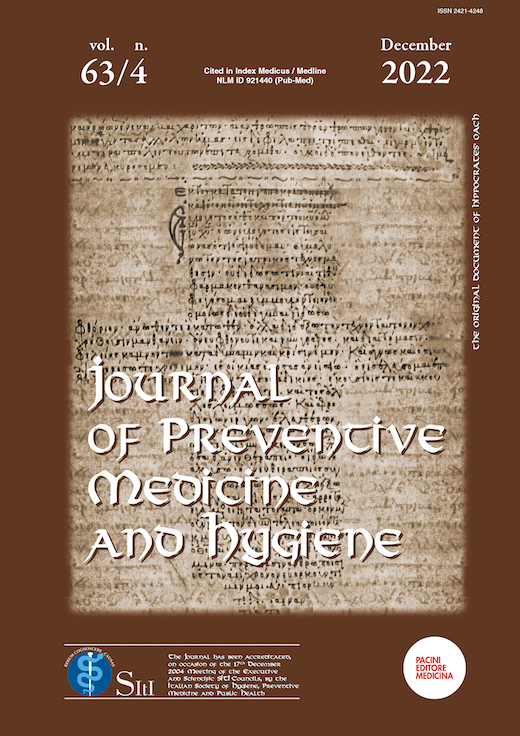Abstract
Introduction: A large proportion of all pregnancies worldwide occur in young adolescent women, and almost all these pregnancies are unintentional. To address effective educational interventions, it is necessary to assess adolescents’ knowledge on this topic. The aim of this study was to translate and validate the Italian version of the SexContraKnowinstrument.
Methods: This was a methodological study. The validation of the instrument was performed following the EORTC Quality of Life Group translation procedure. The process consisted of four phases: translation, content validation, face validation, and pilot test. Data were collected between May and September 2021.
Results: After performing forward and backward translations, we evaluated content validity (Scale-Content Validity Index=0.91) and face validity. We then conducted a pilot test, test re-test, with 10 students (Cronbach α=0.928; Pearson’s R=0.991).
Conclusion: The Italian Version of the SexContraKnow instrument has a good level of validation and reliability and can be effectively used by nurses to assess adolescents’ knowledge about the use of contraceptives and to develop targeted educational interventions. This instrument will help to evaluate the effectiveness of education programmes about health literacy about safe sex and contraception. The attention of nurses should be actively directed towards the process of health literacy among adolescents, in the perspective of a society focused on the empowerment of the population.
References
1. The Calgary Charter on Health Literacy (2008). Rationale and Core Principles for the Development of Health Literacy Curricula.
http://www.centreforliteracy.qc.ca/sites/default/files/CFL_Calgary_Charter_2011.pdf
2. Akca A, Ayaz-Alkaya S. Effectiveness of health literacy education for nursing students: A randomized controlled trial. Int J Nurs Pract 2021; 27(5): e12981. https://doi.org/10.1111/ijn.12981
3. Ayaz-Alkaya S, Terzi H. Investigation of health literacy and affecting factors of nursing students. Nurse Educ Pract 2019; 34: 31–35. https://doi.org/10.1016/j.nepr.2018.10.009
4. Singh NS, Smith J, Aryasinghe S, Khosla R, Say L, Blanchet K. Evaluating the effectiveness of sexual and reproductive health services during humanitarian crises: A systematic review. PloS One 2018; 13(7): e0199300. https://doi.org/10.1371/journal.pone.0199300
5. Sanz-Martos S, López-Medina IM, Álvarez-García C, Álvarez-Nieto C. Sexuality and contraceptive knowledge in university students: instrument development and psychometric analysis using item response theory. Reprod Health 2019; 16(1): 127. https://doi.org/10.1186/s12978-019-0791-9
6. World Health Organisation, (2018). Survive, Thrive, Transform. Global Strategy for Women’s, Children’s and Adolescents’ Health (2016–2030)2018 monitoring report: current status and strategic priorities. https://www.who.int/life-course/partners/global-strategy/gswcah-monitoring-report-2018.pdf?ua=1 (Accessed 5 October 2021)
7. Okan O, Paakkari L, Dadaczynski K. (2020). SHE factsheet nº 6, Health literacy in schools, state of the art. https://www.schoolsforhealth.org/sites/default/files/editor/fact-sheets/factsheet-2020-english.pdf (Accessed 5 October 2021)
8. World Health Organization (1998). Health Promotion Glossary.
https://www.who.int/healthpromotion/about/HPR%20Glossary%201998.pdf
(Accessed 5 October 2021)
9. World Health Organization (2006). Sexual and Reproductive Health and Research (SRH), sexual health definition. https://www.who.int/teams/sexual-and-reproductive-health-and-research/key-areas-of-work/sexual-health/defining-sexual-health (Accessed 5 October 2021)
10. Korkmaz Aslan G, Kartal A, Turan T, Taşdemir Yiğitoğlu G, Kocakabak C. Association of electronic health literacy with health-promoting behaviours in adolescents. Int J Nurs Pract 2021; 27(2): e12921. https://doi.org/10.1111/ijn.12921
11. World Health Organization. Adolescence: a period needing special attention. Age--not the whole story. Available from: http://apps.who.int/adolescent/second-decade/section2/page2/age-not-the-whole-story.html (Accessed 5 January 2021)
12. Todd N, Black A. Contraception for Adolescents. J Clin Res Pediatr Endocrinol 2020;12(Suppl 1), 28–40. https://doi.org/10.4274/jcrpe.galenos.2019.2019.S0003
13. Sørensen K, Pelikan JM, Röthlin F, Ganahl K, Slonska Z, Doyle G, Fullam J, Kondilis B, Agrafiotis D, Uiters E, Falcon M, Mensing M, Tchamov K, van den Broucke S, Brand H, HLS-EU Consortium. Health literacy in Europe: comparative results of the European health literacy survey (HLS-EU). Eur J Public Health 2015; 25(6): 1053–1058. https://doi.org/10.1093/eurpub/ckv043
14. Morales Díaz E, Solanelles Rojas AM, Mora González SR, Miranda Gómez O. Embarazo no deseado en alumnas universitarias. Rev Cub Med Mil 2013;42(2), 153-163.
15. World Health Organization. (2012). Health 2020: A European policy framework supporting action across government and society for health and well-being. Proceedings of Regional Committee for Europe.
https://www.euro.who.int/__data/assets/pdf_file/0006/199536/Health2020-Short.pdf
(Accessed 5 January 2021)
16. López F, Fuertes A. (1999). Para comprender la sexualidad. Navarra: Varios.
17. White AL, Mann ES, Larkan F. Contraceptive knowledge, attitudes, and use among adolescent mothers in the Cook Islands. Sex Reprod Healthc 2018; 16: 92–97. https://doi.org/10.1016/j.srhc.2018.02.004
18. Aziken ME, Okonta PI, Ande AB. Knowledge and perception of emergency contraception among female Nigerian undergraduates. Int Fam Plan Perspect 2003; 29(2): 84–87. https://doi.org/10.1363/ifpp.29.084.03
19. Istituto Superiore di Sanità (2000) Reproductive health among adolescents: knowledge, attitude and behaviour. Rapporti ISTISAN 00/7.
https://www.salute.gov.it/imgs/C_17_pubblicazioni_778_allegato.pdf
20. Italian Ministry of Health (2018). Principali risultati del Progetto “Studio Nazionale Fertilità”, Indagini sulle conoscenze, comportamenti e atteggiamenti in ambito sessuale e riproduttivo in adolescenti, studenti universitari e adulti in età fertile e dei professionisti sanitari. https://www.salute.gov.it/imgs/C_17_pubblicazioni_2823_allegato.pdf (Accessed 5 January 2021)
21. Spanish Society of Contraception. National survey on contraception; 2018.
http://hosting.sec.es/descargas/encuesta2018.pdf (Accessed 5 January 2021)
22. Istituto Superiore di Sanità (2020) La sorveglianza HBSC 2018 – Health Behaviour in School-aged Children: i risultati dello studio italiano tra i ragazzi di 11, 13 e 15 anni. https ://www.epicentro.iss.it/hbsc/pdf/HBSC-2018.pdf (Accessed 5 January 2021)
23. Ayaz-Alkaya S, Terzi H, Işık B, Sönmez E. A healthy lifestyle education programme for health literacy and health-promoting behaviours: A pre-implementation and post-implementation study. Int J Nurs Pract 2020; 26(2): e12793. https://doi.org/10.1111/ijn.12793


